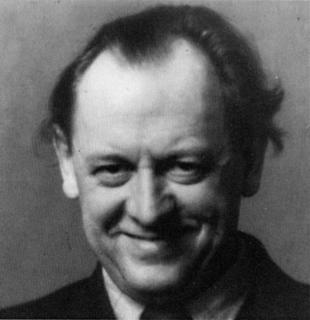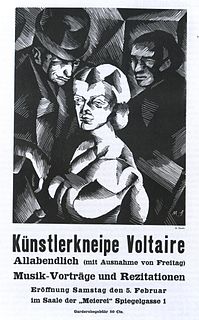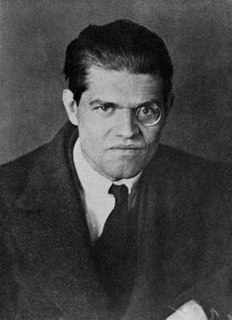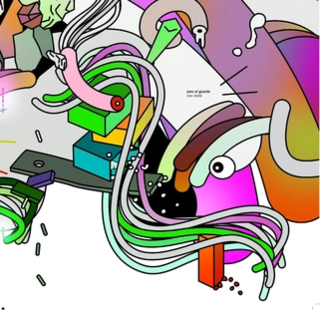Neo-Dada was an art movement. The term may also refer to:
- Neo-Dada Organizers, a Japanese art collective
- Neo Dada (album), 2009 album by Jono El Grande
Neo-Dada was an art movement. The term may also refer to:

Dada or Dadaism was an art movement of the European avant-garde in the early 20th century, with early centres in Zürich, Switzerland, at the Cabaret Voltaire. New York Dada began c. 1915, and after 1920 Dada flourished in Paris. Dadaist activities lasted until c. the mid 1920s.

Kurt Hermann Eduard Karl Julius Schwitters was a German artist who was born in Hanover, Germany.
Hans Richter was a German painter, graphic artist, avant-gardist, film-experimenter and producer. He was born in Berlin into a well-to-do family and died in Minusio, near Locarno, Switzerland.

The avant-garde are people or works that are experimental, radical, or unorthodox with respect to art, culture, or society. It is frequently characterized by aesthetic innovation and initial unacceptability.
An art movement is a tendency or style in art with a specific common philosophy or goal, followed by a group of artists during a specific period of time, or, at least, with the heyday of the movement defined within a number of years. Art movements were especially important in modern art, when each consecutive movement was considered as a new avant-garde movement.

Cabaret Voltaire was the name of an artistic nightclub in Zürich, Switzerland. It was founded by Hugo Ball, with his companion Emmy Hennings, in the back room of Holländische Meierei, Spiegelgasse 1, on February 5, 1916, as a cabaret for artistic and political purposes. Other founding members were Marcel Janco, Richard Huelsenbeck, Tristan Tzara, and Sophie Taeuber-Arp and Jean Arp.

Neo-Dada was a movement with audio, visual and literary manifestations that had similarities in method or intent with earlier Dada artwork. It sought to close the gap between art and daily life, and was a combination of playfulness, iconoclasm, and appropriation. In the United States the term was popularized by Barbara Rose in the 1960s and refers primarily, although not exclusively, to work created in that and the preceding decade. There was also an international dimension to the movement, particularly in Japan and in Europe, serving as the foundation of Fluxus, Pop Art and Nouveau réalisme.

Raoul Hausmann was an Austrian artist and writer. One of the key figures in Berlin Dada, his experimental photographic collages, sound poetry, and institutional critiques would have a profound influence on the European Avant-Garde in the aftermath of World War I.
Anti-art is a loosely used term applied to an array of concepts and attitudes that reject prior definitions of art and question art in general. Somewhat paradoxically, anti-art tends to conduct this questioning and rejection from the vantage point of art. The term is associated with the Dada movement and is generally accepted as attributable to Marcel Duchamp pre-World War I around 1914, when he began to use found objects as art. It was used to describe revolutionary forms of art. The term was used later by the Conceptual artists of the 1960s to describe the work of those who claimed to have retired altogether from the practice of art, from the production of works which could be sold.

Fountain is a readymade sculpture by Marcel Duchamp in 1917, consisting of a porcelain urinal signed "R. Mutt". In April 1917, an ordinary piece of plumbing chosen by Duchamp was submitted for an exhibition of the Society of Independent Artists, the inaugural exhibition by the Society to be staged at The Grand Central Palace in New York. In Duchamp's presentation, the urinal's orientation was altered from its usual positioning. Fountain was not rejected by the committee, since Society rules stated that all works would be accepted from artists who paid the fee, but the work was never placed in the show area. Following that removal, Fountain was photographed at Alfred Stieglitz's studio, and the photo published in The Blind Man. The original has been lost.

Jono El Grande is the stage name of Jon Andreas Håtun.
Dada, or Dadaism, was an early 20th century art movement

Twentieth-century art—and what it became as modern art—began with modernism in the late nineteenth century. Nineteenth-century movements of Post-Impressionism, Art Nouveau and Symbolism led to the first twentieth-century art movements of Fauvism in France and Die Brücke in Germany. Fauvism in Paris introduced heightened non-representational colour into figurative painting. Die Brücke strove for emotional Expressionism. Another German group was Der Blaue Reiter, led by Kandinsky in Munich, who associated the blue rider image with a spiritual non-figurative mystical art of the future. Kandinsky, Kupka, R. Delaunay and Picabia were pioneers of abstract art. Cubism, generated by Picasso, Braque, Metzinger, Gleizes and others rejected the plastic norms of the Renaissance by introducing multiple perspectives into a two-dimensional image. Futurism incorporated the depiction of movement and machine age imagery. Dadaism, with its most notable exponents, Marcel Duchamp, who rejected conventional art styles altogether by exhibiting found objects, notably a urinal, and too Francis Picabia, with his Portraits Mécaniques.

Dada Life are a Swedish DJ duo formed in 2006, which consists of Olle Cornéer and Stefan Engblom. They have released two albums, a number of singles and remixes and one compilation. The duo had early chart success in Belgium and the Netherlands, while their second album The Rules of Dada reached the Billboard 200. They are known for their humour during their live performances, while their name is a homage to the absurdist movement of the early twentieth century. They have released two audio plugins programmed by Tailored Noise: Endless Smile, a drop editor plugin and Sausage Fattener, a saturator.
Gothic or Gothics may refer to:
Kieren Gallear also known as DELS is a British art recording artist, art director, graphics designer and filmmaker born in Ipswich, England, currently based in London. Gallear signed with the Ninja Tune imprint Big Dada in May 2010.

Neo Dada is a music album by the Norwegian composer and artist Jono El Grande, released by Rune Grammofon on 16 March 2009.
"Love to Say Dada" is an unfinished song that was written by American musician Brian Wilson for the Beach Boys' Smile project. It referenced the drug LSD in its initials and was one of the last tracks recorded for the album. The song subsequently evolved into "Cool, Cool Water" from Sunflower (1970).
Neo-Dada Organizers was a short-lived but influential Japanese Neo-Dadaist art collective formed by Masunobu Yoshimura in 1960. Composed of a small group of young, up-and-coming artists who met periodically at Yoshimura's "White House" atelier in Shinjuku, the Neo-Dada Organizers engaged in all manner of visual and performance artworks, but specialized in producing disturbing, impulsive spectacles, often involving physical destruction of objects, that the art critic Ichirō Hariu deemed "savagely meaningless," and that inspired another art critic, Yoshiaki Tōno, to coin the term "anti-art" (han-geijutsu). Examples included filling galleries with piles of garbage, smashing furniture to the beat of jazz music, and prancing the streets of Tokyo in various states of dress and undress. Using the human body as their medium of art, their violent performances reflected both their dissatisfaction with the restrictive environment of the Japanese art world at the time, as well as contemporary social developments, most notably the massive 1960 Anpo protests against the U.S.-Japan Security Treaty.